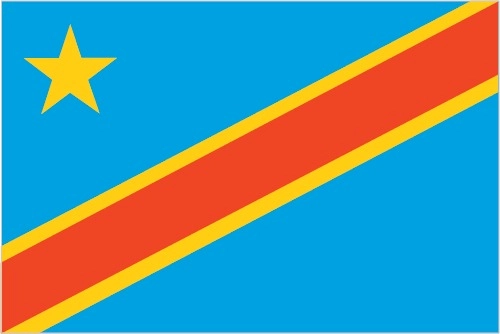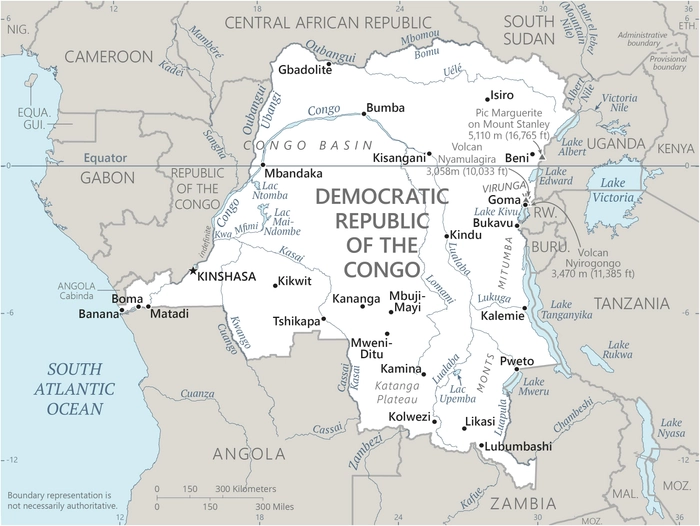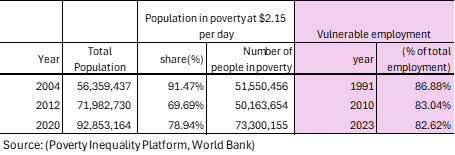
Democratic Rep. Congo
Country Flag Details
sky blue field divided diagonally from the lower hoist corner to upper fly corner by a red stripe bordered by two narrow yellow stripes; a yellow, five-pointed star appears in the upper hoist corner; blue represents peace and hope, red the blood of the country’s martyrs, and yellow the country’s wealth and prosperity; the star symbolizes unity and the brilliant future for the country.
Background
After several centuries of local governance, the Kingdoms of Kongo, Luba, and Lunda emerged and ruled different parts of the Congo River Basin until the end of the 19th Century. European conquest in the 1870s brought the territory under the control of Belgian King LEOPOLD II and later the Belgian state. The Republic of the Congo gained its independence from Belgium in 1960. The country’s name was changed to Zaire in 1971 and to Democratic Republic of the Congo in 1997.

Geography
Area
total : 2,344,858 sq km
land: 2,267,048 sq km
water: 77,810 sq km
Climate
tropical; hot and humid in equatorial river basin; cooler and drier in southern highlands; cooler and wetter in eastern highlands; north of Equator – wet season (April to October), dry season (December to February); south of Equator – wet season (November to March), dry season (April to October)
Natural resources
cobalt, copper, niobium, tantalum, petroleum, industrial and gem diamonds, gold, silver, zinc, manganese, tin, uranium, coal, hydropower, timber
People and Society
Population
total: 115,403,027
Ethnic groups
more than 200 African ethnic groups of which the majority are Bantu; the four largest groups – Mongo, Luba, Kongo (all Bantu), and the Mangbetu-Azande (Hamitic) – make up about 45% of the population
Languages
French (official), Lingala (a trade language), Kingwana (a dialect of Kiswahili or Swahili), Kikongo, Tshiluba
Religions
Christian 93/1% (Roman Catholic 29.9%, Protestant 26.7%, other Christian 36.5%), Kimbanguist 2.8%, Muslim 1.3%, other (includes syncretic sects and indigenous beliefs) 1.2%, none 1.3%, unspecified 0.2% (2014 est.)
Population growth rate
3.11% (2024 est.)
Government
Government type
semi-presidential republic
Capital name: Kinshasa
Executive branch
chief of state: President Felix TSHISEKEDI (since 20 January 2024)
head of government: Prime Minister Judith SUMINWA Tuluka (since 29 May 2024)
Your Title Goes Here
Real GDP (purchasing power parity)
$154.012 billion (2023 est.)
$141.867 billion (2022 est.)
$130.244 billion (2021 est.)
Real GDP per capita
$1,500 (2023 est.)
$1,400 (2022 est.)
$1,300 (2021 est.)
Exports
$29.65 billion (2023 est.)
$28.753 billion (2022 est.)
$22.354 billion (2021 est.)
Exports – partners
China 69%, UAE 7%, India 3%, Spain 3%, Egypt 3% (2023)
Exports – commodities
refined copper, cobalt, copper ore, raw copper, crude petroleum (2023)
Imports
$33.68 billion (2023 est.)
$31.699 billion (2022 est.)
$22.193 billion (2021 est.)
Imports – partners
China 35%, Zambia 12%, South Africa 12%, India 5%, Belgium 4% (2023)
Imports – commodities
trucks, refined petroleum, stone processing machines, plastic products, sulphur (2023)

Export structure by product group in 2023 (% of total exports) (UNCTAD)
The export structure of a country reflects the diversity, composition, and monetary value of its goods and services exchanged in the global market, providing essential insights into its economic health, competitive position, and overall level of development. In the Democratic Republic of the Congo, this structure is primarily defined by its abundant mineral resources, particularly copper and cobalt, which constitute a significant portion of the nation’s total exports. While these natural resources present considerable opportunities for economic growth, it is vital to address the inherent structural challenges and actively encourage diversification within the economy to ensure long-term sustainable development and resilience.

Poverty and vulnerable employment in DRC (World Bank)
In 2023, a staggering 83 percent of total employment in DRC was classified as vulnerable employment, which refers to work characterized by insufficient job security, meager wages, and a lack of vital social protections such as health insurance, pensions, or labor rights. This category predominantly encompasses own-account workers, who are individuals working for themselves without employees, including street vendors and small-scale farmers, as well as contributing family workers, who assist in family businesses or farms without formal pay. These roles are often informal and unstable, lacking essential support systems, which leaves workers particularly susceptible to economic shocks, exploitation, and the persistent threat of poverty. The consequences of this precarious employment extend well beyond the individual, impacting families and communities and perpetuating cycles of instability and hardship that are exceedingly difficult to overcome.
Understanding significance of poverty level at $2.15 per day
In 2020, over 73 million (80% of the population) lived in poverty at $2.15 per day. The poverty level at $2.15 per day (measured in 2017 purchasing power parity, or PPP) is a key global benchmark used by the World Bank to define extreme poverty in low-income countries. It indicates:
1. Basic Survival Threshold
• People living below $2.15 per day struggle to afford essential needs such as food, clean water, shelter, healthcare, and education.
2. Economic Underdevelopment
• A high percentage of a country’s population living below this threshold suggests low economic productivity, high unemployment, and weak social safety nets.
3. Inequality and Social Vulnerability
• It reflects deep income inequality and a lack of access to opportunities for upward mobility.
• People in this category are more vulnerable to shocks like food price increases, climate disasters, or health crises.
4. Policy Challenges
• Governments need targeted interventions such as social welfare programs, job creation, and improved access to education and healthcare to reduce poverty.
A country's export structure is a reflection of its level of development and productive capacities
The export structure of a country refers to the composition, diversity, and value of the goods and services it sells to other countries. It provides key insights into the country’s economic health, competitiveness, and level of development. Productive capacities of a country refer to its ability to produce goods and services efficiently and sustainably over time. These capacities are shaped by various factors, including human capital, natural resources, infrastructure, private sector, development, technology & innovation, institutions & governance, financial systems trade & market access.
Here’s what the export structure and productive capacities of a country typically indicate:
- Level of Economic Development
- Developed economies usually export high-value manufactured goods, technology, and services.
- Developing economies often rely on raw materials, agricultural products, or low-value manufactured goods.
- Industrial and Sectoral Strengths
- A strong presence of high-tech or industrial goods (e.g., machinery, electronics) suggests a well-developed manufacturing sector.
- A dominance of commodities (e.g., oil, minerals, agricultural products) indicates reliance on natural resources.
- Export Diversification
- A diverse export base (multiple industries) makes a country’s economy more stable and resilient to global price shocks.
- A concentrated export base (few key products) makes it vulnerable to market fluctuations.
- Trade Partnerships and Dependence
- If exports are heavily dependent on a single country or region, the economy is more exposed to geopolitical and trade risks.
- A wide range of trading partners indicates stronger global integration.
- Competitiveness and Value Addition
- Exporting mainly raw materials (e.g., crude oil instead of refined petroleum) suggests limited industrial processing capacity.
- A high share of finished and high-tech goods suggests strong value addition and competitiveness.
Congo, Dem.Rep. – Sanitation
Congo Dem. Rep – Proportion of population served with at least basic sanitation
In 2022, the proportion of the population served with at least basic sanitation for Congo, Dem. Rep 16.2%. The proportion of the population served with at least basic sanitation in Congo, Dem. Rep declined from 23.7% in 2000 to 16.2 % in 2022 an absolute change of 7.5 percentage points (pp) decrease between 2000 and 2022.
Congo Dem. Rep. – Proportion of urban population served with at least basic sanitation
In 2022, the proportion of the urban population served with at least basic sanitation for Congo, Dem. Rep was 21.8 %. The proportion of urban population served with at least basic sanitation in Congo, Dem. Rep declined from 23.7% in 2000 to 21.8% in 2022, an absolute change of 1.9 pp between 2000 and 2022.
Congo Dem. Rep. – Proportion of rural population served with at least basic sanitation
In 2022, the proportion of the rural population served with at least basic sanitation for Congo, Dem. Rep was 11.2 %. The proportion of rural population served with at least basic sanitation in Congo, Dem. Rep declined from 23.8% in 2000 to 11.2 % in 2022, an absolute change of 12.6 pp between 2000 and 2022.
Congo Dem. Rep.-Share of the population using at least basic sanitation facilities: A Global Perspective
The issue of inadequate sanitation leads to countless lives lost each year and access to safe sanitation is a fundamental right essential for health, dignity, and security. In 2022, only 16.2% of the population in Congo, Dem. Rep. had basic sanitation, while 92% in Vietnam enjoyed adequate facilities. Globally, 6% of people still face the consequences of insufficient sanitation, highlighting the urgent need for collective action. We must unite to address these disparities, as ensuring access to safe sanitation is crucial for building healthier communities and empowering individuals to live with dignity and respect.

Congo, Dem. Rep.- Share of rural population using at least basic sanitation: A Global Perspective
As we confront the pressing challenge of sanitation access for the rural population in the Democratic Republic of Congo, we must acknowledge a troubling reality that calls for our empathy. In 2022, just 11.2% of the rural populace, approximately 6 million out of 53 million individuals, had adequate sanitation facilities, falling below the global average of 12.1%. This alarming disparity, particularly when contrasted with countries like China, Sri Lanka, and Thailand—where sanitation access rates reach 92.9%, 94.9%, and 98.4% respectively—underscores the critical need for united action. Safe sanitation is not merely a necessity; it is an essential human right. By ensuring that every person can access the dignity and respect associated with proper sanitation, we can foster healthier communities and enhance lives. Let us come together to advocate for this vital cause and strive toward a future where everyone enjoys the basic facilities they rightfully deserve.

Congo, Dem. Rep.-Water Supply
Congo, Dem.Rep – Proportion of the total population served with at least basic drinking water
In 2022, the proportion of the population served with at least basic drinking water for Congo, Dem. Rep. was 35.1 %. Proportion of population served with at least basic water in Congo, Dem. Rep declined from 37.6% in 2000 to 35.1% in 2022, an absolute change of 2.5 pp between 2000 and 2022.
Congo Dem. Rep – Proportion of urban population served with at least basic drinking water
In 2022, the proportion of the urban population served with at least basic water for Congo, Dem. Rep 59.3 %. The proportion of urban population served with at least basic water in Congo, Dem. Rep. fell from 70.7% in 2000 to 59.3% in 2022, an absolute change of 11.4 pp between 2000 and 2022.
Congo Dem Rep.. – Proportion of rural population with at least basic drinking water
In 2022, the proportion of the rural population served with at least basic water for Congo, Dem. Rep. was 13.8 %. The proportion of the rural population served with at least basic drinking water in Congo, Dem. Rep. fell from 19.6% in 2000 to 13.8% in 2022 an absolute change of 5.8pp between 2000 and 2022.
Congo, Dem. Rep.-share of the population using at least basic drinking water facilities: A Global Perspective
Access to safe drinking water is a fundamental human right. In 2022, only 35 million of the 99 million people in the Democratic Republic of the Congo had access to safe drinking water, just 35% of the population. In contrast, countries like Korea and Vietnam achieved full access that same year. Clean water is essential for public health and development, aiding in disease prevention, education, and economic growth. The ongoing clean water crisis in the Democratic Republic of the Congo highlights the urgent need for collective action and investment in infrastructure. By prioritizing clean water initiatives, we can foster a healthier future for all, creating a positive impact across the nation.

Congo, Dem. Rep.-share of the rural population using at least basic drinking water facilities
Access to safe drinking water is a fundamental human right that everyone deserves. Without it, people face increased risks of disease and malnutrition, resulting in millions of preventable deaths each year. Despite global advancements, rural Sub-Saharan Africa remains critically underserved. In 2022, just 13.8 percent of the rural population in the Democratic Republic of Congo—about 7 million out of 53 million—had access to safe drinking water, contrasting sharply with countries like Thailand and Vietnam. The lack of clean water impacts not only health but also education and economic development, trapping families in a cycle of poverty. Urgent action is essential to ensure equitable access to safe drinking water by promoting collaboration among governments, NGOs, and local communities for sustainable solutions.

Congo, Dem.Rep.-Access to Electricity
Congo Dem. Rep-Access to Electricity (% of population)
In 2022, the proportion of the population with access to electricity in Congo, Dem.Rep.was 21.5 %. The proportion of the population with access to electricity in Congo, Dem. Rep. increased from 6.7 % in 2000 to 21.5% in 2022, an absolute change of 14.8 pp between 2000 and 2022.
Congo, Dem. Rep.-Access to Electricity (% urban population)
In 2022, the proportion of the urban population with access to electricity for Congo, Dem. Rep was 45.3 %. The proportion of the urban population with access to electricity in Congo, Dem. Rep increased from 20.0% in 2000 to 45.3 % in 2022, an absolute change of 25.3 pp between 2000 and 2022.
Angola- Access to Electricity (% rural population)
In 2022, the proportion of the rural population with access to electricity in Congo, Dem. Rep was 1.0% %. The proportion of the rural population with access to electricity in Congo, Dem. Rep was 1.0% in 2020, an absolute change of 0.0% between 2020 and 2022.
Democratic Republic of Congo- Share of the population with access to electricity: A Global Perspective
Access to electricity is crucial for breaking the cycle of poverty and improving living conditions. In 2022, only 21.5 percent, about 22 million of the 99 million people in the Democratic Republic of the Congo, had electricity, illustrating a significant struggle. Meanwhile, countries like Thailand, Vietnam, and Indonesia achieved 100 percent electricity access, highlighting stark inequalities. This broader view of global figures shows that many developing nations have much higher access rates, emphasizing the ongoing challenges in Sub-Saharan Africa.

Democratic Republic of Congo- Share of the rural population with access to Electricity: A Global Perspective
In 2022, a mere 1% of the rural population in the Democratic Republic of Congo had access to electricity, a stark contrast to the nearly universal electricity access enjoyed by rural communities in various Asian nations. This alarming disparity underscores the urgent necessity for transformative change and dedicated support for countries in Sub-Saharan Africa that continue to face significant challenges in securing reliable power sources. It is crucial that we come together to address these inequities, as access to electricity is a fundamental aspect of development that can drive economic growth, improve quality of life, and empower communities to thrive.

Congo, Dem. Rep. – Health Outcomes
Democratic Republic of Congo-Life Expectancy
Over the past seventy years, life expectancy worldwide has seen a remarkable shift, reflecting advancements in healthcare, nutrition, and living conditions. In 1950, the global average life expectancy for newborns was only 47 years, a striking reminder of earlier hardships. By 2021, this average rose to 71 years, showcasing significant progress in public health and medical technology. However, improvements have not been uniform, with nations in Sub-Saharan Africa, such as the Democratic Republic of Congo, experiencing only modest gains; life expectancy there increased from 40.9 years in 1960 to 59.7 years in 2022. In contrast, the Maldives saw an extraordinary leap from 39 years in 1960 to 81 years in 2022, illustrating the success of effective healthcare and economic policies. For further insights into these trends, please refer to the accompanying chart.

Democratic Republic of Congo-Maternal mortality ratio (per 100,000 live births): A Global Perspective
The maternal mortality ratio is a vital measure of women’s health, highlighting the tragic loss of lives due to pregnancy complications. This ratio captures fatalities during pregnancy or within 42 days postpartum, expressed per 100,000 live births. In 2020, the Democratic Republic of Congo reported a ratio of 547 deaths per 100,000 live births, showing slight improvement from 668 in 2000, yet indicating a pressing need for better healthcare interventions. In contrast, China, Sri Lanka, and South Korea achieved remarkable progress, with rates of 23, 29, and 8 deaths per 100,000 live births respectively. Ensuring safe motherhood is a critical challenge that requires urgent attention to healthcare services, education, and community support. We encourage you to engage with the accompanying chart and participate in our shared mission to promote healthier families and a sustainable future for the Democratic Republic of Congo.

Democratic Republic of Congo-Under-5 mortality ( per 1000 live births): A Global Perspective
The under-five mortality rate is a vital measure of the likelihood that a newborn will not survive past age five, expressed per 1,000 live births. In 2022, the Democratic Republic of the Congo reported a mortality rate of 75.6 deaths, a significant decrease from 212.8 in 1980. Since 1950, global child mortality has improved due to better living standards, healthcare access, nutrition, and clean water. While Europe and North America have reduced their rates to under 4 percent, many Sub-Saharan African countries still face major challenges. In 1980, both the Democratic Republic of the Congo and Bangladesh had high mortality rates of 212.8 and 206, respectively; however, by 2022, Bangladesh reduced its rate to 29, while the Democratic Republic of the Congo remains at 75.6.
